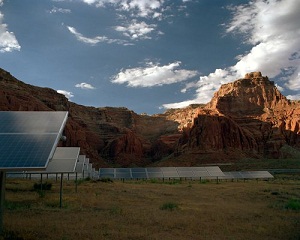Week in review: Solar jobs continue to grow, First Solar SunPower report Q3 results
 Heading into the end of the election season it’s hard not to concentrate on who’s going be president after Nov. 6, that said, there was some positive news coming from the solar industry last week. Two new reports came out showing that growth in solar jobs has remained strong and is likely to continue that trend. Meanwhile both First Solar and SunPower, the U.S.’s integrated PV companies reported third quarter 2012 results, with First Solar beating earnings estimates and SunPower’s earnings were below estimates. On the research side of things there were two interesting developments, Amonix announced a new real-world efficiency breakthrough that touches on the limits of the possible and Stanford researchers created the first all carbon PV cells.
Heading into the end of the election season it’s hard not to concentrate on who’s going be president after Nov. 6, that said, there was some positive news coming from the solar industry last week. Two new reports came out showing that growth in solar jobs has remained strong and is likely to continue that trend. Meanwhile both First Solar and SunPower, the U.S.’s integrated PV companies reported third quarter 2012 results, with First Solar beating earnings estimates and SunPower’s earnings were below estimates. On the research side of things there were two interesting developments, Amonix announced a new real-world efficiency breakthrough that touches on the limits of the possible and Stanford researchers created the first all carbon PV cells.
The Solar Foundation released preliminary results of its 2012 National Solar Jobs Census. The report found that the U.S. solar industry now employs 119,016 people, growing by 13.3 percent over last year’s 105,145 employees. Overall the U.S. saw a 2.3 percent growth in jobs.
Just a few days earlier a new report from CleanEdison, which provides renewable energy training services, determined that solar jobs are continuing to grow but its figures are much different than The Solar Foundation’s. The Clean Edison report anticipates that solar will grow by 24 percent, from 15,987 jobs in 2010 to 36,618 in 2020. The discrepancies in the numbers can be attributed to accounting methodologies, but the message of both is that solar and green jobs are growing. In all CleanEdison’s report anticipates that green jobs will grow to more than 3 million jobs in the U.S. by 2020.
Among this jobs backdrop, PV manufacturers are still having a tough time of it. SunPower Corp. and First Solar Inc. are looking to increase their project development pipelines while continuing to innovate on the module side. SunPower reported $650 million in revenue, up 18 percent year over year, but still operated at a $48.5 million net loss during the quarter. First Solar reported sales of $839 million during the quarter. It’s net income was $87.9 million. Both companies lowered their full-year guidance as well.
Amonix turned some brows last week when it announced that it broke a world record in real-world testing, when the National Renewable Energy Laboratory determined that its mega-modules were 33.5 percent efficient at producing electricity from the sun. The company beat its own 30.3 percent record for real-world testing in doing so. The company is now working on integrating the advances in optics and cooling into it’s next generation of concentrating PV modules.
Over at Stanford University, researchers created a photovoltaic cell that’s built entirely of carbon structures. The researches were looking for a way to eliminate expensive and rare metals from PV cells. While carbon-based PV cells have been developed before, the laboratory used carbon both in the photoreactive layer and the electrode layers of the cell. The research could result in cheap-to make PV that could be applied on cars or building walls, for instance.
The Bureau of Land Management announced last month that it would move forward with its plan to allow solar on certain BLM managed lands deemed appropriate for solar projects. Now it’s already planning on opening up more land for potential solar development. Last week it proposed creating an additional Solar Energy Zone in Arizona. The land being looked at is a 2,550-acre zone in Yuma County, Ariz.’s Agua Caliente area, which is no stranger to solar projects.



